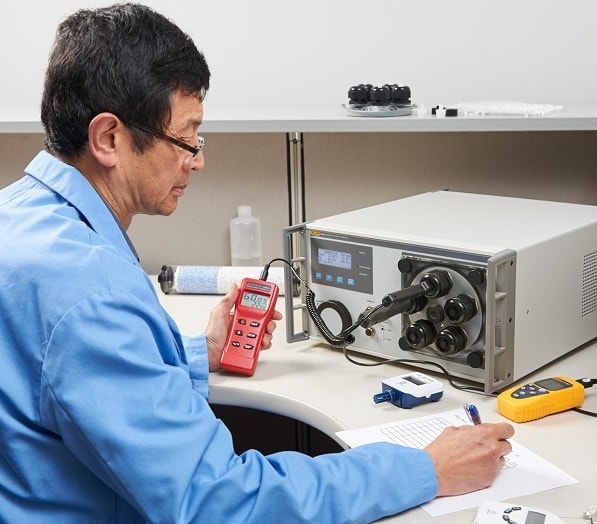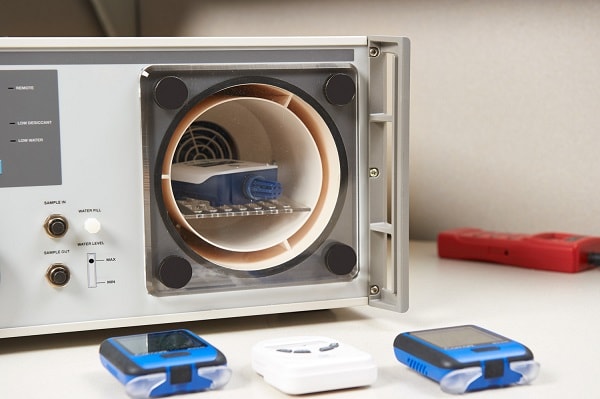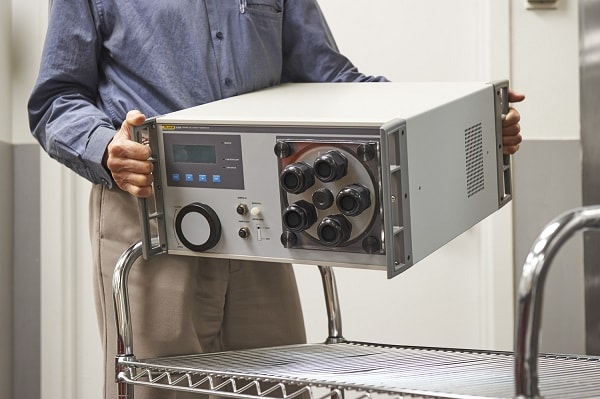- Other Fluke companies:
- Fluke
- Fluke Biomedical
- Fluke Networks
- Fluke Process Instruments
Is it Time to Set Up Your Own In-House, Humidity Calibration and Measuring Lab?

Humidity sensors are a crucial component of quality control in a manufacturing environment. Often, they are found in “clean rooms” (not to be confused with operating rooms) where a tightly controlled environment — meaning controlled temperature, humidity, and air purity — is critical to product quality and reduction of environmental hazard risks.
Humidity sensors can pose some unique challenges for metrologists, but the process you should follow for determining if in-house humidity sensor calibration is right for you isn’t remarkably different from other return on investment (ROI) calculations. In this article, I’d like to take you through the steps you should follow when you’re determining if in-house humidity calibration is right for you.
First, Calculate Your In-House Humidity Calibration ROI
One of the advantages of bringing humidity sensor calibration in-house is reducing the cost of downtime. You can look at the cost of downtime in a couple ways.
One contributor to ROI is the expense of downtime. How long will it take to calibrate humidity sensors that are critical to manufacturing? And, what will it cost? Another factor in the ROI calculation is the cost of spare humidity sensors you need to maintain production while your sensors are out for calibration.
Understanding these numbers is your starting place to calculate ROI for in-house calibration; or to put it simply, ROI is the amount of time it will take for you to realize a more efficient cost of calibration by purchasing a calibrator and performing sensor calibration in your own lab.
Let’s look at an example
- If you need to maintain 50 humidity sensors across your facilities, and each one is calibrated twice a year at $300 each, that’s $30,000 per year in calibration costs. This is a good place to start your calculation, but there are a few other factors to include.
- If you don't have spare humidity sensors, next look at how much down time will cost while your sensors are out for calibration. Let’s say that for each day a sensor is down, it costs $100 in lost production time. A 5-day calibration turnaround could cost $500 per week per sensor. Multiplying by 50 sensors, downtime could rise as high as $25,000 per year, in this example.
- A very simplified formula to describe this is:
ROI = net income (or cost savings) generated by the equipment divided by the cost of equipment purchase and operation.
The result of this equation will give you a rough idea of how many years it will take for you to achieve breakeven by purchasing your own humidity generator / calibrator. For many businesses, the ROI of setting up humidity calibration in-house may be among the business' top investment options. However, there are many variables that can also be added, which will vary depending on the nature of your business and the regulations you must adhere to.
If you have questions or would like help analyzing the ROI of purchasing humidity calibration equipment, you may speak with one of our humidity calibration product experts.
Next, Determine Your Uncertainty and Regulatory Requirements
For many customers I work with, an important factor is regulatory requirements.
This will vary greatly depending on your industry. Food and pharmaceutical, for instance, have tight regulatory requirements, and production facilities for these goods will want in-house humidity generators / calibrators on hand to verify that their equipment is within spec between calibrations.
Some types of manufacturing can depend heavily on humidity sensors, for example electronics, or manufacturing environments where low humidity can cause a dust explosion. However, even in industries where humidity issues won’t cause hazards, they can cause costly manufacturing defects and recalls, and in-house humidity generators for intermediate checks (also known as “verification”) can prevent costly problems before they happen.
Equally important (which, again, may be part of your industry’s regulatory standards) is your required Test Uncertainty Ratio (TUR). This is how accurate your calibrator needs to be to give you confidence that your calibration is within a suitable margin of error. No calibration is ever going to be infinitely accurate, but a 4:1 TUR is generally considered ideal.
(As a reminder, a 4:1 TUR means that the device you’re calibrating with is four times more accurate than the sensor you’re calibrating. So if you’re calibrating a humidity sensor within 4% RH, you’ll need a calibrator that’s accurate to within 1% RH. This is because if you’re plus 1% RH or minus 1% RH, the end user of the sensor has 2% RH of uncertainty left to work with to still be within specifications. This allows enough room for error in the readouts, leads, environment and all the other variables involved in any measurement that can contribute small amounts of error to your final measurement.)
Finally, Consider Sensor Size and Portability

-
Shape and size: Sensors — particularly for humidity — come in a vast array of shapes and sizes. There are probes, fixtures, and hygrometers with LED displays. Our 5128A RHapid-Cal Humidity Generator has two options for doors that you can swap out, one to accommodate up to five humidity probes in its grommets, and a transparent door so you can read a sensor with an LED display as you perform humidity calibration procedures. The chamber is also non-porous and uses distilled water, as humidity sensors may sometimes contact food or other contaminants, so being able to wipe down the inside of the chamber is often a crucial feature.
-
Adjustability: Keep in mind that it’s not uncommon for humidity sensors to not be adjustable; nevertheless, a “pass / fail” test result is still a meaningful result of routine humidity calibration. Whether you adjust your humidity sensor, or simply discard it when it’s out of calibration, you still want to know that you can trust your readings from the device.

Calibration technician demonstrating the portability of the Fluke 5128A humidity generator calibrator -
Portability and number of sites: If you have several clean rooms in your facility, it might not be convenient to completely uninstall humidity sensors to calibrate them. A portable humidity generator / calibrator, like the 5128A, is small enough to move on a cart and lift by hand, so you won’t be limited to laboratory use. It’s also been designed with a relatively fast power cycle, which is an important consideration as well as for humidity generators in general, powering up and down can be a time-consuming process.
Even if you don’t have multiple clean rooms now, or even if you only have one type of humidity sensor currently, it’s still a great idea to consider whether you will have them in the future and select a humidity generator / calibrator that can accommodate your needs down the road as well.
Do you have a question about in-house humidity calibration and measurement? Give us a call at 877-355-3224, email me directly at travis.porter@flukecal.com, or request a sales consultation. If you’d like to learn more about metrology, we offer online and in-person metrology and calibration training, as well as free on-demand webinars on more than 100 metrology and calibration topics.
Related products
5128A RHapid-Cal® Humidity Generator
Related application notes
Understanding uncertainties associated with the 5128A RHapid-Cal® Humidity Generator
Get Help
Speak with a calibration product expert about your equipment needs
- Início
- Produtos
- Novos Produtos
- Calibração elétrica
- Calibração de RF
- Equipamento de aquisição de dados e de teste
- Calibração de temperatura
- Calibração de umidade
- Calibração de pressão
- Medidores de pistão
- Controlador/Calibradores
- Monitores de pressão
- Balanças de peso morto
- Calibradores manuais e monitores
- Handheld Pressure Calibrators
- Calibração de dados de aéreos
- Monitores ambientais
- Acessórios de calibração de pressão
- Sistemas personalizados de calibração de pressão
- Software de calibração de pressão
- Calibração de fluxo
- Ferramentas de Calibração de processo
- Software de calibração
- Serviço e suporte
- Todos os instrumentos de calibração
- Onde Comprar
- Notícias
- Treinamento e eventos
- Literatura e educação
- Serviço e Suporte
- Service Request (RMA)
- Planos de Serviço
- Suporte técnico
- Base de Conhecimento
- Acreditações
- Centros de assistência autorizados
- Calibration Certificates
- Community Forum
- My MET/SUPPORT
- Manuais de produto (Guias de usuário)
- Folhas de Dados de Segurança (SDS)
- Safety, Service, and Product Notices
- Downloads de software
- Sobre Nós

